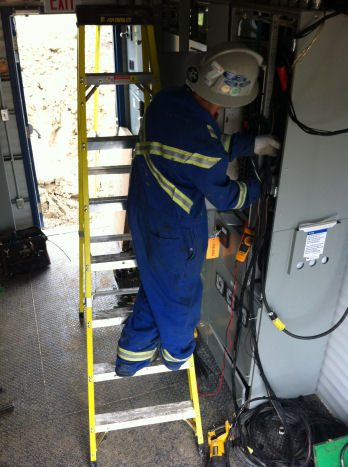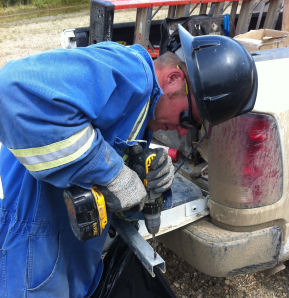Vital Workplace Safety Tips for Safety at Work
Keeping a few workplace safety tips in mind may well save your life. The first thing you learn when training to become an electrician is how to work safely. It is everybody’s responsibility to keep the workplace safe.

Working with electricity requires extreme care. The electrical currents running through homes and businesses have enough power to severely injure, or kill.
Even something as simple as changing a light bulb while the lamp is still plugged into the outlet can be hazardous. Coming in contact with the live part of the socket can cause electrocution.
Workplace Safety Tips: Static vs Dynamic Electricity
Every electrical system has the potential to cause serious harm. Electricity is either static or dynamic.
Static electricity is an accumulative charge as a result of friction. You may experience this when you’re walking on carpet, or when you open your car door after a journey. Static electricity can be painful in the moment, but is seldom dangerous, unless there is a flammable gas in the area.
A dynamic electric current runs through a conductor. Most conductors are made of metal. In order to exist, an electric current needs an unbroken line to and from a load through the conductor. This allows electricity to form a loop.
For example, when you plug in a power tool, the electricity flows from the plug, to the tool and then back to the source of power. This is known as completing the circuit.
Injuries occur when people become part of this circuit. Human beings are excellent conductors: that means if a you get into the path of the flowing electricity, it will try to flow through your body.
Workplace Safety Tips: Avoiding Electrocution
Getting in the way of the current can cause electrocution, electric shock, falls and burns. These injuries can happen by:

- Inspect your tools, power cords and all electrical fittings for excessive wear or damage every time you use them. Repair or replace any damaged equipment right away.
- Keep cords out of the way by taping them to the floor or the wall. Do not use nails or staples, as they can damage the cord and cause shock or fire hazards.
- Only use equipment rated for the wattage or amperage you are working with.
- Always use the right size of fuse. A larger size fuse can cause an excessive current and maybe start a fire.
- Watch out for unusually hot outlets. These may a sign of unsafe wiring conditions within the wall. Unplug all cords using the outlet, and do not use the outlet until a qualified electrician checks the wiring.
- Always use wooden or fiberglass ladders, or some other non-conductive material.
- Keep halogen lights away from any combustible materials, like cleaning cloths or drapes. Halogen lamps may become extremely hot and become a fire hazard.
- The chance of electric shock increases in damp or wet conditions. Installing ground fault circuit interrupters can help. They can stop the electrical circuit before it can cause serious injury or death.
- Ensure any exposed receptacle boxes are non-conductive. Touching a receptacle box made of conductive materials can cause shock or electrocution.
- Make sure you know where all of the breakers are located in case of emergency.
- Make sure circuit breakers and fuse boxes are marked clearly. Every switch should properly identify which appliance or outlet it supplies.
- Never use cords or outlets with exposed wiring. Do not just tape up the exposed wires. Replace the cord, or have the outlet properly repaired right away.
- Never use power tools that have their safety guards removed. The safety guards were put there for a reason; to keep you safe. Taking them off defeats their purpose, and creates a hazard for you or colleagues.
- Never block access to fuse boxes or circuit breakers. Someone may need to reach them in an emergency. Blocking access can turn a minor incident into a serious accident.
- Never grab a person or an electrical tool during an electrical accident. Make sure to disconnect the power first. You do not want to watch someone being electrocuted, but becoming part of the circuit yourself will not help him. Disconnecting the power may save his life.
Workplace Safety Tips: Working With Power Tools
When working with power tools, remember these workplace safety tips:

- Make sure power tools are turned off before plugging them into a power supply.
- Store power tools in a clean dry place. Dust and dirt can get into gears and motor windings, reducing the life.
- Disconnect the power supply before you make any adjustments.
- Make sure your tools are grounded properly, or double insulated. A grounded tool must have the correct three wire cord with a three-prong plug. The plug must be plugged into a proper three-pole outlet, which is properly grounded.
- Test your tools before use with a ground fault circuit interrupter or a continuity tester for effective grounding.
- Do not operate tools by plugging in and disconnecting the power cord. Always use the switch to turn the tool on and off.
- Never operate electrical tools in damp or wet conditions, unless it is connected to a ground fault circuit interrupter.
Stay safe when working with electricity. Keep these workplace safety tips in mind at all times.





